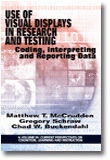
Use of Visual Displays in Research and Testing
Coding, Interpreting, and Reporting Data
Edited by:
Matthew T. McCrudden, Victoria University of Wellington
Gregory Schraw, University of Nevada - Las Vegas
Chad Buckendahl, Alpine Testing
A volume in the series: Current Perspectives on Cognition, Learning and Instruction. Editor(s): Daniel H. Robinson, University of Texas at Arlington. Marlynn M. Griffin, Georgia Southern University.
Published 2015
Visual displays play a crucial role in knowledge generation and communication. The purpose of the volume is to provide researchers with a framework that helps them use visual displays to organize and interpret data; and to communicate their findings in a comprehensible way within different research (e.g., quantitative, mixed methods) and testing traditions that improves the presentation and understanding of findings. Further, this book includes contributions from leading scholars in testing and quantitative, qualitative, and mixed methods research, and results reporting. The volume’s focal question is: What are the best principles and practices for the use of visual displays in the research and testing process, which broadly includes the analysis, organization, interpretation, and communication of data?
The volume is organized into four sections. Section I provides a rationale for this volume; namely, that including visual displays in research and testing can enhance comprehension and processing efficiency. Section II includes addresses theoretical frameworks and universal design principles for visual displays. Section III examines the use of visual displays in quantitative, qualitative, and mixed methods research. Section IV focuses on using visual displays to report testing and assessment data.
CONTENTS
SECTION I: INTRODUCTION. Visual Displays in Research and Testing: Theoretical and Practical Considerations, Matthew T. McCrudden, Gregory Schraw, and Chad W. Buckendahl. SECTION II: THEORETICAL FRAMEWORKS AND DESIGN PRINCIPLES. Design Principles for Visual Displays: Past, Present, and Future, Antonio P. Gutierrez, Gregory Schraw, and Andreas Stefik. Guidelines for Making Graphs Easy to Perceive, Easy to Understand, and Information Rich, David M. Lane. Examining the Type, Frequency, and Interpretative Complexity of Visual Displays Appearing in the Journal of Educational Psychology, 2010–2014, Gregory Schraw and Antonio P. Gutierrez. SECTION III: VISUAL DISPLAYS IN QUANTITATIVE, QUALITATIVE, AND MIXED METHODS RESEARCH. Promoting the Use of Path Diagrams in Quantitative Research, Dena A. Pastor and Sara J. Finney. Using Joint Displays and MAXQDA Software to Represent the Results of Mixed Methods Research, Tim Guetterman, John W. Creswell, and Udo Kuckartz. The Use of Visual Displays in Mixed Methods Research: Strategies for Effectively Integrating the Quantitative and Qualitative Components of a Study, Vicki L. Plano Clark and Khahlia Sanders. Use Of Concept Maps to Facilitate Student Learning in Research and Measurement Courses, Florian Feucht, Gwen Marchand, and Lori Olafson. SECTION IV: VISUAL DISPLAYS TO REPORT TESTING AND ASSESSMENT DATA. The Graphic Representation of Findings From the National Center on Assessment and Accountability for Special Education, Keith Zvoch and Joseph J. Stevens. Tailoring Visual Displays to Improve Test Score Interpretation: Including Indicators of Uncertainty, Brett P. Foley. Visual Displays for Reporting Test Data: Making Sense of Test Performance, April L. Zenisky. Biographies.
-
Paperback978-1-68123-101-3
Web price: $45.04 (Reg. 52.99)
-
Hardcover978-1-68123-102-0
Web price: $80.74 (Reg. 94.99)
- eBook978-1-68123-103-7

- EDU037000 - EDUCATION: Research
- EDU000000 - EDUCATION: General
- PSY008000 - PSYCHOLOGY: Cognitive Psychology
-
 Assessment of Higher Order Thinking Skills
Assessment of Higher Order Thinking Skills
-
 Learning Through Visual Displays
Learning Through Visual Displays
-
 Misinformation and Fake News in Education
Misinformation and Fake News in Education
-
 Recent Innovations in Educational Technology that Facilitate Student Learning
Recent Innovations in Educational Technology that Facilitate Student Learning
-
 Social Media
Influences on Education
Social Media
Influences on Education
-
 Teachers’ Personal Epistemologies
Evolving Models for Informing Practice
Teachers’ Personal Epistemologies
Evolving Models for Informing Practice
-
 Technology-Based Assessments for 21st Century Skills
Theoretical and Practical Implications from Modern Research
Technology-Based Assessments for 21st Century Skills
Theoretical and Practical Implications from Modern Research

